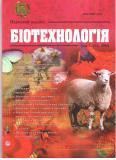ISSN 1995-5537

“Biotechnology” journal V. 1, № 2, 2008
Р. 81-92, Bibliography 33, Ukrainian.
Universal Decimal classification 631.811.98
Institute of Bioorganic Chemistry and Petro
chemistryof the National Academy of Sciences of Ukraine, Kyiv
Kholodny Institute of Botany ofthe National Academy of Sciences of Ukraine, Kyiv
Pacific Northwest National Laboratory, USA
Kholodny Institute of Botany ofthe National Academy of Sciences of Ukraine, Kyiv
Pacific Northwest National Laboratory, USA
α-Amanitin (a specific inhibitor of mRNA synthesis) and Actinomycin D (that blocks primarily rRNA synthesis) were used to inhibit mRNA and rRNA synthesis in sprouting bean seeds. It was demonstrated that prior to completion of the bean seed germination lag-phase (18 hours) with inhibited mRNA and rRNA synthesis following seed upswelling (after 6 hours), protein biosynthesis processes are triggered and their duration actively increases in embryonic axis cells. Based on the above, we came to the conclusion that during the earliest stage of postembryogenesis, mRNA and rRNA transcripts stocked during late embryogenesis are involved in the initiation of protein biosynthesis; and newly synthesized mRNA and rRNA are also involved in the biosynthesis before root emergence (after 18 hours).
Aphidicolin that selectively suppresses DNA replication helped to determine that increasing needs in gene expression products (proteins) at early stages of postembryogenesis are satisfied by amplification of both structural and ribosomal genes. Stimulating effect of plant growth regulators is not related to additional amount of gene copies, but rather to gene activation through intensification of promoter and enhancer functions of gene regulatory sequences via activation of protein transfactors.
The concept of exogenous plant growth regulators behavior at genetic level has been formulated.Key words: embryonic axis, RNA synthesis, gene amplification, growth regulators.
© Palladin Institute of Biochemistry of National Academy of Sciences of Ukraine, 2008

